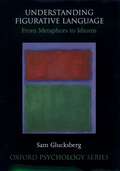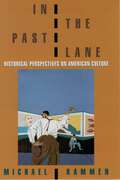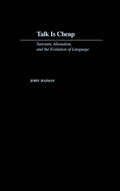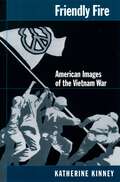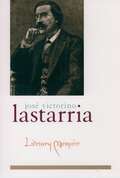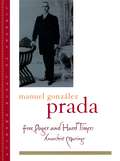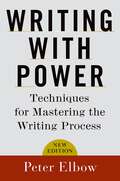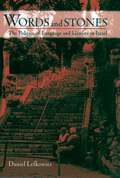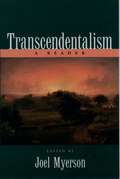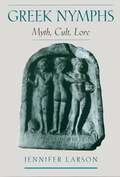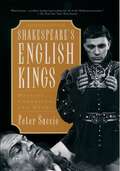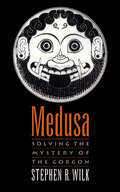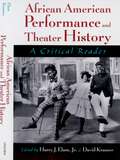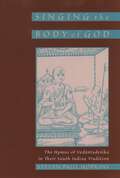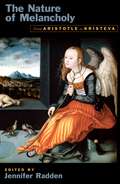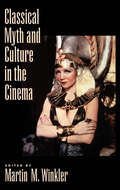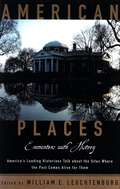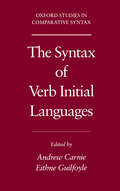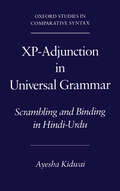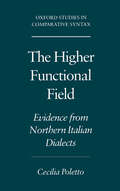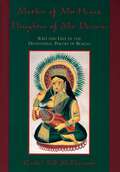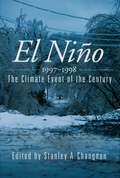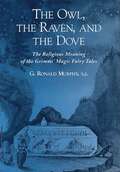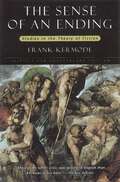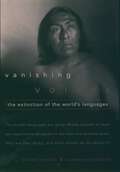- Table View
- List View
Understanding Figurative Language: From Metaphor to Idioms (Oxford Psychology Series #36)
by Sam GlucksbergThis book examines how people understand utterances that are intended figuratively. Traditionally, figurative language such as metaphors and idioms has been considered derivative from more complex than ostensibly straightforward literal language. Glucksberg argues that figurative language involves the same kinds of linguistic and pragmatic operations that are used for ordinary, literal language. Glucksberg's research in this book is concerned with ordinary language: expressions that are used in daily life, including conversations about everyday matters, newspaper and magazine articles, and the media. Metaphor is the major focus of the book. Idioms, however, are also treated comprehensively, as is the theory of conceptual metaphor in the context of how people understand both conventional and novel figurative expressions. A new theory of metaphor comprehension is put forward, and evaluated with respect to competing theories in linguistics and in psychology. The central tenet of the theory is that ordinary conversational metaphors are used to create new concepts and categories. This process is spontaneous and automatic. Metaphor is special only in the sense that these categories get their names from the best examples of the things they represent, and that these categories get their names from the best examples of those categories. Thus, the literal "shark" can be a metaphor for any vicious and predatory being, from unscrupulous salespeople to a murderous character in The Threepenny Opera. Because the same term, e.g.,"shark," is used both for its literal referent and for the metaphorical category, as in "My lawyer is a shark," we call it the dual-reference theory. The theory is then extended to two other domains: idioms and conceptual metaphors. The book presents the first comprehensive account of how people use and understand metaphors in everyday life.
In the Past Lane: Historical Perspectives on American Culture
by Michael KammenMichael Kammen is widely regarded as one of our most important--and most diversely talented--cultural historians. David Brion Davis has said, "No other historian of [his] generation has such a broad and concrete grasp of 'American culture' in all its manifestations, from constitutional law to formal painting and popular culture." This engaging volume stands as rich and compelling evidence of that assertion. In the Past Lane collects writings from a span of more than ten years, covering the broad spectrum of Kammen's recent interests. Essay topics include the role of the historian, the relationship between culture and the State, uses of tradition in American commercial culture, American historical art, memory distortion in American history, the contested uses of history in American education, and others. The book will be seen as an important contribution to Kammen's wide-ranging scholarship--and to American cultural history proper. "For professional historians or serious students of history, Kammen's essays provide an excellent opportunity to gauge how those who chronicle our past both influence and are influenced by national and personal experiences."--Booklist
Talk Is Cheap: Sarcasm, Alienation, and the Evolution of Language
by John HaimanPutting aside questions of truth and falsehood, the old "talk is cheap" maxim carries as much weight as ever. Indeed, perhaps more. For one need not be an expert in irony or sarcasm to realize that people don't necessarily mean what they say. Phrases such as "Yeah, right" and "I couldn't care less" are so much a part of the way we speak--and the way we live--that we are more likely to notice when they are absent (for example, Forrest Gump). From our everyday dialogues and conversations ("Thanks a lot!") to the screenplays of our popular films (Pulp Fiction and Fargo), what is said is frequently very different from what is meant. Talk is Cheap begins with this telling observation and proceeds to argue that such "unplain speaking" is fundamentally embedded in the way we now talk. Author John Haiman traces this sea-change in our use of language to the emergence of a postmodern "divided self" who is hyper-conscious that what he or she is saying has been said before; "cheap talk" thus allows us to distance ourselves from a social role with which we are uncomfortable. Haiman goes on to examine the full range of these pervasive distancing mechanisms, from clichés and quotation marks to camp and parody. Also, and importantly, this text highlights several new ways in which the English language is evolving (and has evolved) in response to our postmodern world view. In other words, this study shows us how what we are saying is gradually separating itself from how we say it. As provocative as it is timely, the book will be fascinating reading for students of linguistics, literature, communication, anthropology, philosophy, and popular culture.
Friendly Fire: American Images of the Vietnam War
by Katherine KinneyHundreds of memoirs, novels, plays, and movies have been devoted to the American war in Vietnam. In spite of the great variety of media, political perspectives and the degrees of seriousness with which the war has been treated, Katherine Kinney argues that the vast majority of these works share a single story: that of Americans killing Americans in Vietnam. Friendly Fire, in this instance, refers not merely to a tragic error of war, it also refers to America's war with itself during the Vietnam years. Starting from this point, this book considers the concept of "friendly fire" from multiple vantage points, and portrays the Vietnam age as a crucible where America's cohesive image of itself is shattered--pitting soldiers against superiors, doves against hawks, feminism against patriarchy, racial fear against racial tolerance. Through the use of extensive evidence from the film and popular fiction of Vietnam (e.g. Kovic's Born on the Fourth of July, Didion's Democracy, O'Brien's Going After Cacciato, Rabe's Sticks and Bones and Streamers), Kinney draws a powerful picture of a nation politically, culturally, and socially divided, and a war that has been memorialized as a contested site of art, media, politics, and ideology.
Literary Memoirs (Library of Latin America)
by José Victorino LastarriaNovelist, scholar, journalist, statesman, and leading member of Chile's "Generation of 1842"--an intellectual movement so named for the founding of the National University--José Victorino Lastarria (1811-1888) lived his life at the forefront of nineteenth-century Chilean and Spanish American culture, literature, and politics. Recuerdos Literarios (or Literary Memoirs) is his masterpiece, encompassing the candid memories of a tireless activist, both the creative and critical sensibilities of an influential Latin American early modernist, and an eyewitness account of the development of Chilean literature and historiography. An ardent, eloquent participant in every defining artistic and ideological debate in Chile during the formative mid-1800s, Lastarria recorded his epoch as closely as he did his own origins, education, ambitions, and career. Sometimes reminiscent of Montaigne's essays, Eça de Quieroz's journalism, or Barbusse's didactic convictions, Literary Memoirs is an engrossing account of Chile's newly ordained nationhood. This addition to Oxford's prestigious Library of Latin America series is more than a retelling of things past; it is an informed yet informal testament to the idea of chilenidad (or "Chileanness") and a detailed portrait of one of Chile's cultural architects. For this new edition of Literary Memoirs, Frederick M. Nunn's introduction presents an informative historical background and R. Kelly Washbourne's translation carefully preserves Lastarria's form and content.
Free Pages and Hard Times: Anarchist Musings (Library Of Latin America Ser.)
by Manuel González PradaManuel González Prada was a powerful Peruvian writer and political reformer whose essays and speeches influenced generations of young radicals. He founded the Party of National Unity in 1891, was linked to the anarchist movement, and served as Director of the National Library from 1912-1914. His writings have had enormous impact on the literary and political life of Peru: taking up the defense of exploited indigenous people, broadsiding the landowning oligarchy, and denouncing the social and political errors of the country. In fact, the radical politics Prada advocated then are still alive and relevant today: Modernization (secularization) of Peru, transformation of a nation through its people, promotion of internationalism (universalism) versus overt patriotism (communitarianism), and condemnation of war. This translation is based on the Obras of González Prada, edited by Luis Alberto Sánchez. It includes essays, speeches and polemical writings drawn from two of Prada's only books of prose published during his lifetime, Paginas Libres and Horas de Lucha, in addition to unpublished manuscripts and works previously printed in newspapers and magazines. His writings are gathered thematically under the subheadings "Peruvian Problems," "Anarchy," and "Philosophical, Literary, and Linguistic Problems."
Writing With Power: Techniques for Mastering the Writing Process
by Peter ElbowA classic handbook for anyone who needs to write, Writing With Power speaks to everyone who has wrestled with words while seeking to gain power with them. Here, Peter Elbow emphasizes that the essential activities underlying good writing and the essential exercises promoting it are really not difficult at all. Employing a cookbook approach, Elbow provides the reader (and writer) with various recipes: for getting words down on paper, for revising, for dealing with an audience, for getting feedback on a piece of writing, and still other recipes for approaching the mystery of power in writing. In a new introduction, he offers his reflections on the original edition, discusses the responses from people who have followed his techniques, how his methods may differ from other processes, and how his original topics are still pertinent to today's writer. By taking risks and embracing mistakes, Elbow hopes the writer may somehow find a hold on the creative process and be able to heighten two mentalities--the production of writing and the revision of it. From students and teachers to novelists and poets, Writing with Power reminds us that we can celebrate the uses of mystery, chaos, nonplanning, and magic, while achieving analysis, conscious control, explicitness, and care in whatever it is we set down on paper.
Words and Stones: The Politics of Language and Identity in Israel (Oxford Studies in Anthropological Linguistics #26)
by Daniel LefkowitzSocial and ethnic identity are nowhere more enmeshed with language than in Israel. Words and Stones explores the politics of identity in Israel through an analysis of the social life of language. By examining the social choices Israelis make when they speak, and the social meanings such choices produce, Daniel Lefkowitz reveals how Israeli identities are negotiated through language. Lefkowitz studies three major languages and their role in the social lives of Israelis: Hebrew, the dominant language, Arabic, and English. He reveals their complex interrelationship by showing how the language a speaker chooses to use is as important as the language they choose not to use - in the same way that a claim to an Israeli identity is simultaneously a claim against other, opposing identities. The result is a compelling analysis of how the identity of "Israeliness" is linguistically negotiated in the three-way struggle among Ashkenazi (Jewish), Mizrahi (Jewish), and Palestinian (Arab) Israelis. Lefkowitz's ethnography of language-use is both thoroughly anthropological and thoroughly linguistic, and provides a comprehensive view of the role language plays in Israeli society. His work will appeal to students and scholars of sociolinguistics, anthropology, and linguistic anthropology, as well as students and scholars of Israel and the Middle East.
Transcendentalism: A Reader
by Joel MyersonThe transcendentalist movement is generally recognized to be the first major watershed in American literary and intellectual history. Pioneered by Emerson, Thoreau, Orestes Brownson, Margaret Fuller, and Bronson Alcott (among others), Transcendentalism provided a springboard for the first distinctly American forays into intellectual culture: religion and religious reform, philosophy, literature, ecology, and spiritualism. This new collection, edited by eminent American literature scholar Joel Myerson, is the first anthology of the period to appear in over fifty years. Transcendentalism: A Reader draws together in their entirety the essential writings of the Transcendentalist group during its most active period, 1836-1844. It includes the major publications of the Dial, the writings on democratic and social reform, the early poetry, nature writings, and all of Emerson's major essays, as well as an informative introduction and annotations by Myerson.
Greek Nymphs: Myth, Cult, Lore
by Jennifer LarsonGreek Nymphs: Myths, Cult, Lore is the first comprehensive study of the nymph in the ancient Greek world. This well-illustrated book examines nymphs as both religious and mythopoetic figures, tracing their development and significance in Greek culture from Homer through the Hellenistic period. Drawing upon a broad range of literary and archaeological evidence, Jennifer Larson discusses sexually powerful nymphs in ancient and modern Greek folklore, the use of dolls representing nymphs in the socialization of girls, the phenomenon of nympholepsy, the nymphs' relations with other deities in the Greek pantheon, and the nymphs' role in mythic narratives of city-founding and colonization. The book includes a survey of the evidence for myths and cults of the nymphs arranged by geographical region, and a special section of the worship of nymphs in caves throughout the Greek world.
Shakespeare's English Kings: History, Chronicle, and Drama
by Peter SaccioFar more than any professional historian, Shakespeare is responsible for whatever notions most of us possess about English medieval history. Anyone who appreciates the dramatic action of Shakespeare's history plays but is confused by much of the historical detail will welcome this guide to the Richards, Edwards, Henrys, Warwicks and Norfolks who ruled and fought across Shakespeare's page and stage. Not only theater-goers and students, but today's film-goers who want to enrich their understanding of film adaptations of plays such as Richard III and Henry V will find this revised edition of Shakespeare's English Kings to be an essential companion. Saccio's engaging narrative weaves together three threads: medieval English history according to the Tudor chroniclers who provided Shakespeare with his material, that history as understood by modern scholars, and the action of the plays themselves. Including a new preface, a revised further reading list, genealogical charts, an appendix of names and titles, and an index, the second edition of Shakespeare's English Kings offers excellent background reading for all of the ten history plays.
Medusa: Solving the Mystery of the Gorgon
by Stephen R. WilkMedusa, the Gorgon, who turns those who gaze upon her to stone, is one of the most popular and enduring figures of Greek mythology. Long after many other figures from Greek myth have been forgotten, she continues to live in popular culture. In this fascinating study of the legend of Medusa, Stephen R. Wilk begins by refamiliarizing readers with the story through ancient authors and classical artwork, then looks at the interpretations that have been given of the meaning of the myth through the years. A new and original interpretation of the myth is offered, based upon astronomical phenomena. The use of the gorgoneion, the Face of the Gorgon, on shields and on roofing tiles is examined in light of parallels from around the world, and a unique interpretation of the reality behind the gorgoneion is suggested. Finally, the history of the Gorgon since tlassical times is explored, culminating in the modern use of Medusa as a symbol of Female Rage and Female Creativity.
African American Performance and Theater History: A Critical Reader
by Harry J. Elam David KrasnerAfrican American Performance and Theater History is an anthology of critical writings that explores the intersections of race, theater, and performance in America. Assembled by two esteemed scholars in black theater, Harry J. Elam, Jr. and David Krasner, and composed of essays from acknowledged authorities in the field, this anthology is organized into four sections representative of the ways black theater, drama, and performance interact and enact continual social, cultural, and political dialogues. Ranging from a discussion of dramatic performances of Uncle Tom's Cabin to the Black Art Movement of the 1960s and early 1970s, articles gathered in the first section, "Social Protest and the Politics of Representation," discuss the ways in which African American theater and performance have operated as social weapons and tools of protest. The second section of the volume, "Cultural Traditions, Cultural Memory and Performance," features, among other essays, Joseph Roach's chronicle of the slave performances at Congo Square in New Orleans and Henry Louis Gates, Jr.'s critique of August Wilson's cultural polemics. "Intersections of Race and Gender," the third section, includes analyses of the intersections of race and gender on the minstrel stage, the plight of black female choreographers at the inception of Modern Dance, and contemporary representations of black homosexuality by PomoAfro Homo. Using theories of performance and performativity, articles in the fourth section, "African American Performativity and the Performance of Race," probe into the ways blackness and racial identity have been constructed in and through performance. The final section is a round-table assessment of the past and present state of African American Theater and Performance Studies by some of the leading senior scholars in the field--James V. Hatch, Sandra L. Richards, and Margaret B. Wilkerson. Revealing the dynamic relationship between race and theater, this volume illustrates how the social and historical contexts of production critically affect theatrical performances of blackness and their meanings and, at the same time, how African American cultural, social, and political struggles have been profoundly affected by theatrical representations and performances. This one-volume collection is sure to become an important reference for those studying black theater and an engrossing survey for all readers of African American literature.
Singing the Body of God: The Hymns of Vedantadesika in Their South Indian Tradition
by Steven Paul HopkinsThis is the first full-length study of the devotional poetry and poetics of the fourteenth-century poet-philosopher Vedantadesika, one of the most outstanding and influential figures in the Hindu tradition of Sri-Vaishnavism (the cult of Lord Vishnu). Despite their intrinsic beauty and theological importance, the poetry and philosophy of Vedantadesika have received very little scholarly attention. But for the millions who belong to the Vaishnava tradition, those poems are not just classical literature; they are committed to memory, recited, sung, and enacted in ritual both in India and throughout the Hindu diaspora. Steven Hopkins here offers a comparative study of the Sanskrit, Prakrit, and Tamil poems composed by Vedantadesika in praise of important Vaishnava shrines and their icons--poems that are considered to be the apogee of South Indian devotional literature.
The Nature of Melancholy: From Aristotle to Kristeva
by Jennifer RaddenSpanning 24 centuries, this anthology collects over thirty selections of important Western writing about melancholy and its related conditions by philosophers, doctors, religious and literary figures, and modern psychologists. Truly interdisciplinary, it is the first such anthology. As it traces Western attitudes, it reveals a conversation across centuries and continents as the authors interpret, respond, and build on each other's work. Editor Jennifer Radden provides an extensive, in-depth introduction that draws links and parallels between the selections, and reveals the ambiguous relationship between these historical accounts of melancholy and today's psychiatric views on depression. This important new collection is also beautifully illustrated with depictions of melancholy from Western fine art.
Classical Myth and Culture in the Cinema
Classical Myth and Culture in the Cinema is a collection of essays presenting a variety of approaches to films set in ancient Greece and Rome and to films that reflect archetypal features of classical literature. The diversity of content and theoretical stances found in this volume will make it required reading for scholars and students interested in interdisciplinary approaches to text and image, and for anyone interested in the presence of Greece and Rome in modern popular culture.
American Places: Encounters with History
by William E. LeuchtenburgIn American Places, more than two dozen of America's most gifted historians write about their encounters with historic places, bringing a personal viewpoint to bear on a wide variety of sites, ranging from Monticello to Fenway Park. Here James M. McPherson writes about the battlefield of Gettysburg, and how walking the ground of Pickett's Charge inspired one of his books. Kevin Starr visits the Musso & Frank Grill in Hollywood and finds many of the flavors of California history there. Joel Williamson takes a bemused tour of Elvis Presley's Graceland, and David Kennedy tells the story of the "Pig War" on San Juan Island, where a spat between Britain and America over a speck of land in the Pacific Northwest helped determine the shape of the U.S. and Canada. William Freehling compares two places, Charleston's Battery and New Orleans' Jackson Square, showing how each reveals the different spirit of the society that created it. And Edward Ayers talks about spending time in Cyberspace, U.S.A. Other pieces include Robert Dallek on the FDR Memorial, David Hackett Fischer on the Boston Common, and William Leuchtenburg on his native borough of Queens. American Places celebrates the career of Sheldon Meyer, who over his years at Oxford University Press has published some of America's most distinguished historians, including many Pulitzer Prize and Bancroft Prize winners, virtually all of whom have contributed to this volume.
The Syntax of Verb Initial Languages (Oxford Studies in Comparative Syntax)
by Andrew Carnie Eithne GuilfoyleThis volume contains twelve chapters on the derivation of and the correlates to verb initial word order. The studies in this volume cover such widely divergent languages as Irish, Welsh, Scots Gaelic, Old Irish, Biblical Hebrew, Jakaltek, Mam, Lummi (Straits Salish), Niuean, Malagasy, Palauan, K'echi', and Zapotec, from a wide variety of theoretical perspectives, including Minimalism, information structure, and sentence processing. The first book to take a cross-linguistic comparative approach to verb initial syntax, this volume provides new data to some old problems and debates and explores some innovative approaches to the derivation of verb initial order.
Xp-Adjunction in Universal Grammar: Scrambling and Binding in Hindi-Urdu (Oxford Studies in Comparative Syntax)
by Ayesha KidwaiOne of the most hotly debated phenomena in natural language is that of leftward argument scrambling. This book investigates the properties of Hindi-Urdu scrambling to show that it must be analyzed as uniformly a focality-driven XP-adjunction operation. It proposes a novel theory of binding and coreference that not only derives the coreference effects in scrambled constructions, but has important consequences for the proper formulation of binding, crossover, reconstruction, and representational economy in the minimalist program. The book will be of interest not only to specialists in Hindi-Urdu syntax and/or scrambling, but to all students of generative syntax.
The Higher Functional Field: Evidence from Northern Italian Dialects (Oxford Studies in Comparative Syntax)
by Cecilia PolettoThis work investigates the syntax of the higher portion of the functional structure of the clause using comparative data from hundreds of Northern Italian dialects. The area contains dialects that are different in most ways yet homogenous syntactically, making it an ideal ground for analyzing micro-variations in syntax. The book sheds new light on debated problems such as subject-clitic inversion, verb movement and subject positions, and the structure of the higher functional phrases.
Mother of My Heart, Daughter of My Dreams: Kali and Uma in the Devotional Poetry of Bengal
by Rachel Fell McDermottThis book chronicles the rise of goddess worship in the region of Bengal from the middle of the eighteenth century to the present. Focusing on the goddesses Kali and Uma, McDermott examines lyrical poems written by devotees from Ramprasad Sen (ca. 1718-1775) to Kazi Nazrul Islam (1899-1976).
El Niño 1997-1998: The Climate Event of the Century
by Stanley A. ChangnonThis book will cover the time span from the first indications of El Nino (May 1997) until its reversal (June 1998). The focus will be largely on the United States, where El Nino produced widespread changes in how the public perceives weather and in the accuracy of forecasts Among the key issues it will examine are how the news media interpreted and dramatixed El Nino and the reaction both of the public and decision-makers (the latter based on interviews with agribusiness, utilities, water management agencies, etc.); the scientific issues emerging from the event; and the social and economic consequences of the event. Finally, it will suggest what can and should be done when El Nino occurs in the future.
The Owl, The Raven, and the Dove: The Religious Meaning of the Grimms' Magic Fairy Tales
by G. Ronald MurphyThe fairy tales collected by the brothers Grimm are among the best known and most widely-read stories in western literature. In recent years commentators such as Bruno Bettelheim have, usually from a psychological perspective, pondered the underlying meaning of the stories, why children are so enthralled by them, and what effect they have on the the best-known tales (Hansel and Gretel, Little Red Riding Hood, Cinderella, Snow White, and Sleeping Beauty) and shows that the Grimms saw them as Christian fables. Murphy examines the arguments of previous interpreters of the tales, and demonstrates how they missed the Grimms' intention. His own readings of the five so-called "magical" tales reveal them as the beautiful and inspiring "documents of faith" that the Grimms meant them to be. Offering an entirely new perspective on these often-analyzed tales, Murphy's book will appeal to those concerned with the moral and religious education of children, to students and scholars of folk literature and children's literature, and to the many general readers who are captivated by fairy tales and their meanings.
The Sense of an Ending: Studies in the Theory of Fiction with a New Epilogue
by Frank KermodeFrank Kermode is one of our most distinguished critics of English literature. Here, he contributes a new epilogue to his collection of classic lectures on the relationship of fiction to age-old concepts of apocalyptic chaos and crisis. Prompted by the approach of the millennium, he revisits the book which brings his highly concentrated insights to bear on some of the most unyielding philosophical and aesthetic enigmas. Examining the works of writers from Plato to William Burrows, Kermode shows how they have persistently imposed their "fictions" upon the face of eternity and how these have reflected the apocalyptic spirit. Kermode then discusses literature at a time when new fictive explanations, as used by Spenser and Shakespeare, were being devised to fit a world of uncertain beginning and end. He goes on to deal perceptively with modern literature with "traditionalists" such as Yeats, Eliot, and Joyce, as well as contemporary "schismatics," the French "new novelists," and such seminal figures as Jean-Paul Sartre and Samuel Beckett. Whether weighing the difference between modern and earlier modes of apocalyptic thought, considering the degeneration of fiction into myth, or commenting on the vogue of the Absurd, Kermode is distinctly lucid, persuasive, witty, and prodigal of ideas.
Vanishing Voices: The Extinction of the World's Languages
by Daniel Nettle Suzanne RomaineFew people know that nearly one hundred native languages once spoken in what is now California are near extinction, or that most of Australia's 250 aboriginal languages have vanished. In fact, at least half of the world's languages may die out in the next century. Daniel Nettle and Suzanne Romaine assert that this trend is far more than simply disturbing. Making explicit the link between language survival and environmental issues, they argue that the extinction of languages is part of the larger picture of near-total collapse of the worldwide ecosystem. Indeed, the authors contend that the struggle to preserve precious environmental resources-such as the rainforest-cannot be separated from the struggle to maintain diverse cultures, and that the causes of language death, like that of ecological destruction, lie at the intersection of ecology and politics. In addition to defending the world's endangered languages, the authors also pay homage to the last speakers of dying tongues, such as Red Thundercloud, a Native American in South Carolina; Ned Mandrell, with whom the Manx language passed away in 1974; and Arthur Bennett, an Australian who was the last person to know more than a few words of Mbabaram. In our languages lies the accumulated knowledge of humanity. Indeed, each language is a unique window on experience. Vanishing Voices is a call to preserve this resource, before it is too late.
